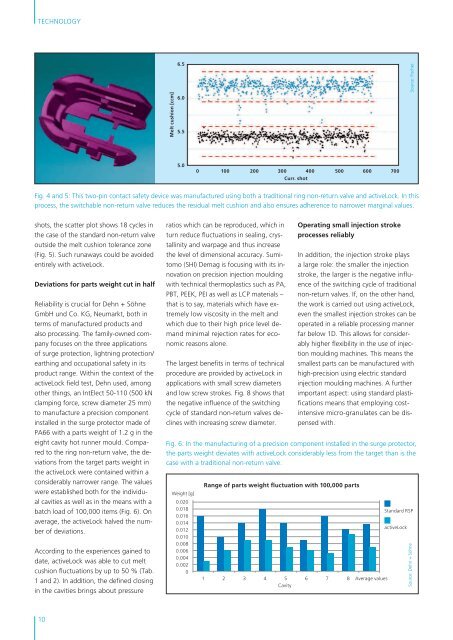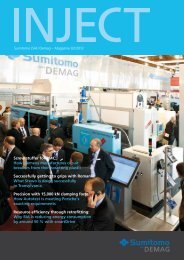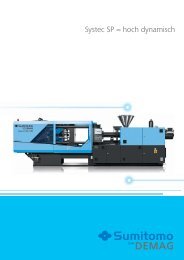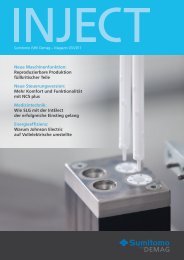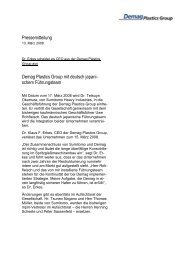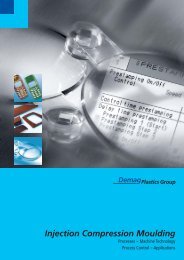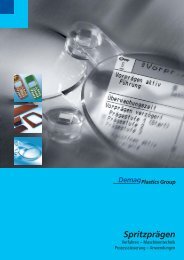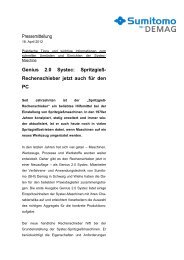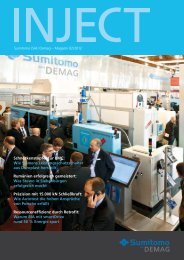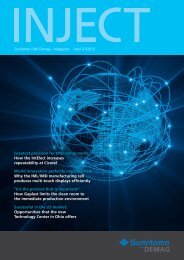Inject_1_2012_en.pdfDownload - Sumitomo (SHI) Demag
Inject_1_2012_en.pdfDownload - Sumitomo (SHI) Demag
Inject_1_2012_en.pdfDownload - Sumitomo (SHI) Demag
You also want an ePaper? Increase the reach of your titles
YUMPU automatically turns print PDFs into web optimized ePapers that Google loves.
TECHNOLOGY<br />
Melt cushion [ccm]<br />
6.5<br />
6.0<br />
5.5<br />
Source: Fischer<br />
5.0<br />
0 100 200 300 400 500 600 700<br />
Curr. shot<br />
Fig. 4 and 5: This two-pin contact safety device was manufactured using both a traditional ring non-return valve and activeLock. In this<br />
process, the switchable non-return valve reduces the residual melt cushion and also <strong>en</strong>sures adher<strong>en</strong>ce to narrower marginal values.<br />
shots, the scatter plot shows 18 cycles in<br />
the case of the standard non-return valve<br />
outside the melt cushion tolerance zone<br />
(Fig. 5). Such runaways could be avoided<br />
<strong>en</strong>tirely with activeLock.<br />
Deviations for parts weight cut in half<br />
Reliability is crucial for Dehn + Söhne<br />
GmbH und Co. KG, Neumarkt, both in<br />
terms of manufactured products and<br />
also processing. The family-owned company<br />
focuses on the three applications<br />
of surge protection, lightning protection/<br />
earthing and occupational safety in its<br />
product range. Within the context of the<br />
activeLock field test, Dehn used, among<br />
other things, an IntElect 50-110 (500 kN<br />
clamping force, screw diameter 25 mm)<br />
to manufacture a precision compon<strong>en</strong>t<br />
installed in the surge protector made of<br />
PA66 with a parts weight of 1.2 g in the<br />
eight cavity hot runner mould. Compared<br />
to the ring non-return valve, the deviations<br />
from the target parts weight in<br />
the activeLock were contained within a<br />
considerably narrower range. The values<br />
were established both for the individual<br />
cavities as well as in the means with a<br />
batch load of 100,000 items (Fig. 6). On<br />
average, the activeLock halved the number<br />
of deviations.<br />
According to the experi<strong>en</strong>ces gained to<br />
date, activeLock was able to cut melt<br />
cushion fluctuations by up to 50 % (Tab.<br />
1 and 2). In addition, the defined closing<br />
in the cavities brings about pressure<br />
ratios which can be reproduced, which in<br />
turn reduce fluctuations in sealing, crystallinity<br />
and warpage and thus increase<br />
the level of dim<strong>en</strong>sional accuracy. <strong>Sumitomo</strong><br />
(<strong>SHI</strong>) <strong>Demag</strong> is focusing with its innovation<br />
on precision injection moulding<br />
with technical thermoplastics such as PA,<br />
PBT, PEEK, PEI as well as LCP materials –<br />
that is to say, materials which have extremely<br />
low viscosity in the melt and<br />
which due to their high price level demand<br />
minimal rejection rates for economic<br />
reasons alone.<br />
The largest b<strong>en</strong>efits in terms of technical<br />
procedure are provided by activeLock in<br />
applications with small screw diameters<br />
and low screw strokes. Fig. 8 shows that<br />
the negative influ<strong>en</strong>ce of the switching<br />
cycle of standard non-return valves declines<br />
with increasing screw diameter.<br />
Operating small injection stroke<br />
processes reliably<br />
In addition, the injection stroke plays<br />
a large role: the smaller the injection<br />
stroke, the larger is the negative influ<strong>en</strong>ce<br />
of the switching cycle of traditional<br />
non-return valves. If, on the other hand,<br />
the work is carried out using activeLock,<br />
ev<strong>en</strong> the smallest injection strokes can be<br />
operated in a reliable processing manner<br />
far below 1D. This allows for considerably<br />
higher flexibility in the use of injection<br />
moulding machines. This means the<br />
smallest parts can be manufactured with<br />
high-precision using electric standard<br />
injection moulding machines. A further<br />
important aspect: using standard plastifications<br />
means that employing costint<strong>en</strong>sive<br />
micro-granulates can be disp<strong>en</strong>sed<br />
with.<br />
Fig. 6: In the manufacturing of a precision compon<strong>en</strong>t installed in the surge protector,<br />
the parts weight deviates with activeLock considerably less from the target than is the<br />
case with a traditional non-return valve.<br />
Weight [g]<br />
0.020<br />
0.018<br />
0.016<br />
0.014<br />
0.012<br />
0.010<br />
0.008<br />
0.006<br />
0.004<br />
0.002<br />
0<br />
Range of parts weight fluctuation with 100,000 parts<br />
1 2 3 4 5 6 7 8 Average values<br />
Cavity<br />
Standard RSP<br />
activeLock<br />
Source: Dehn + Söhne<br />
10


